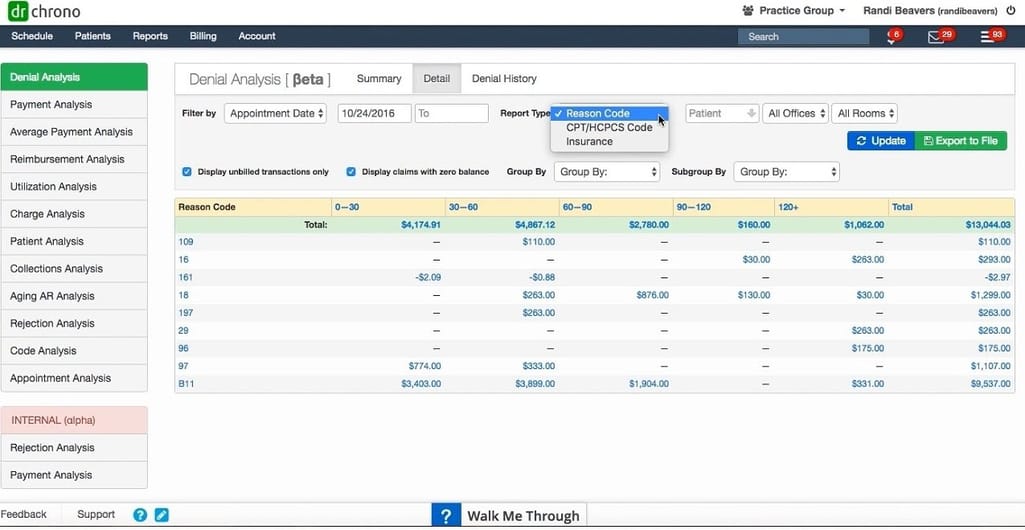Timely payments from customers are the fuel that keeps any business going. Healthcare providers are no exception, but in their case getting paid is a long multi-step journey with numerous regulations and players involved. While hospitals can’t make this way shorter, they may make it faster — by automating billing operations.
In our article about EHR systems, we described several options with the integrated billing module. This time we’ll review separate solutions that focus on medical billing.
Whether you are a physician running your practice, a hospital executive, or a medical billing company representative, this review will help you investigate capabilities of available medical billing software and choose the best option to boost the speed of your cash flow.
Medical billing and healthcare revenue cycle management
Taking good care of patients is only a part of the healthcare puzzle. To run a successful medical practice, providers need to tame the financial beast called RCM or revenue cycle management.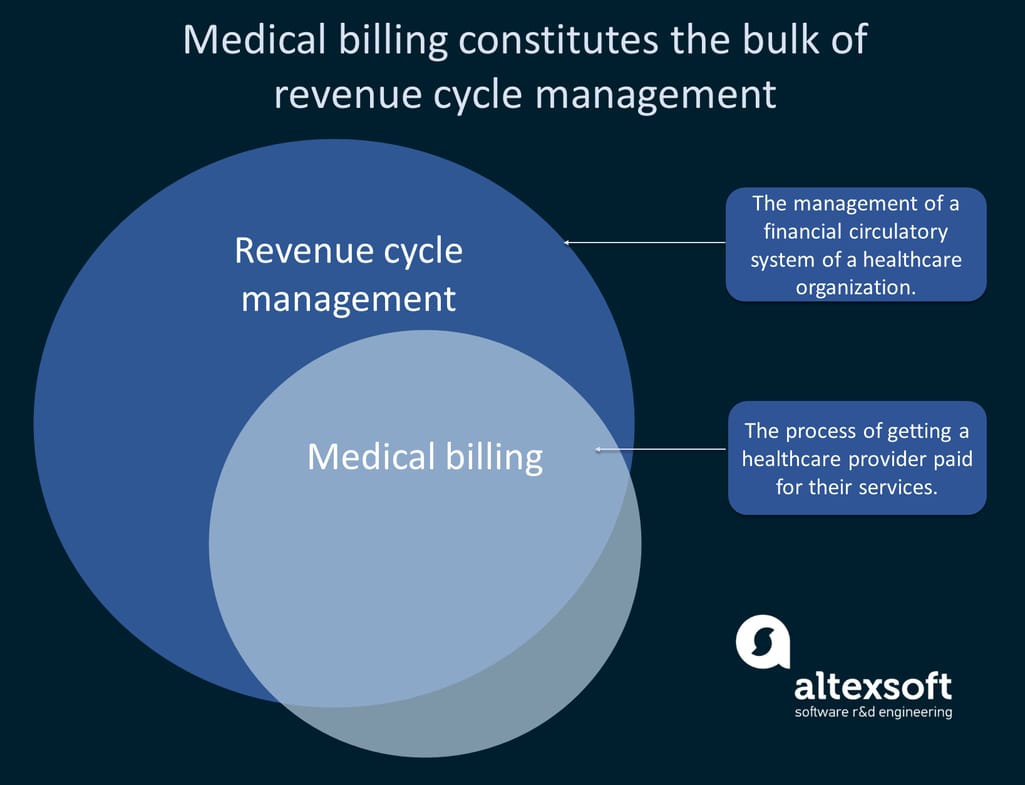
The medical billing system is a vital part of the revenue cycle.
The revenue cycle can be described as the financial circulatory system of a healthcare organization. It comprises both clinical and administrative functions that aim at capturing, managing, and collecting patient service revenue.
The cycle starts from the creation of a patient's account, then goes all way through providing medical services and submitting claims to the endpoint where care providers receive payments either from a patient or through an insurance carrier. The management of this complex system is referred to as healthcare revenue cycle management.
Medical billing is an integral part of the healthcare revenue cycle that consists of getting a healthcare provider paid for their services. This process begins before the services are even provided, and encompasses several important steps.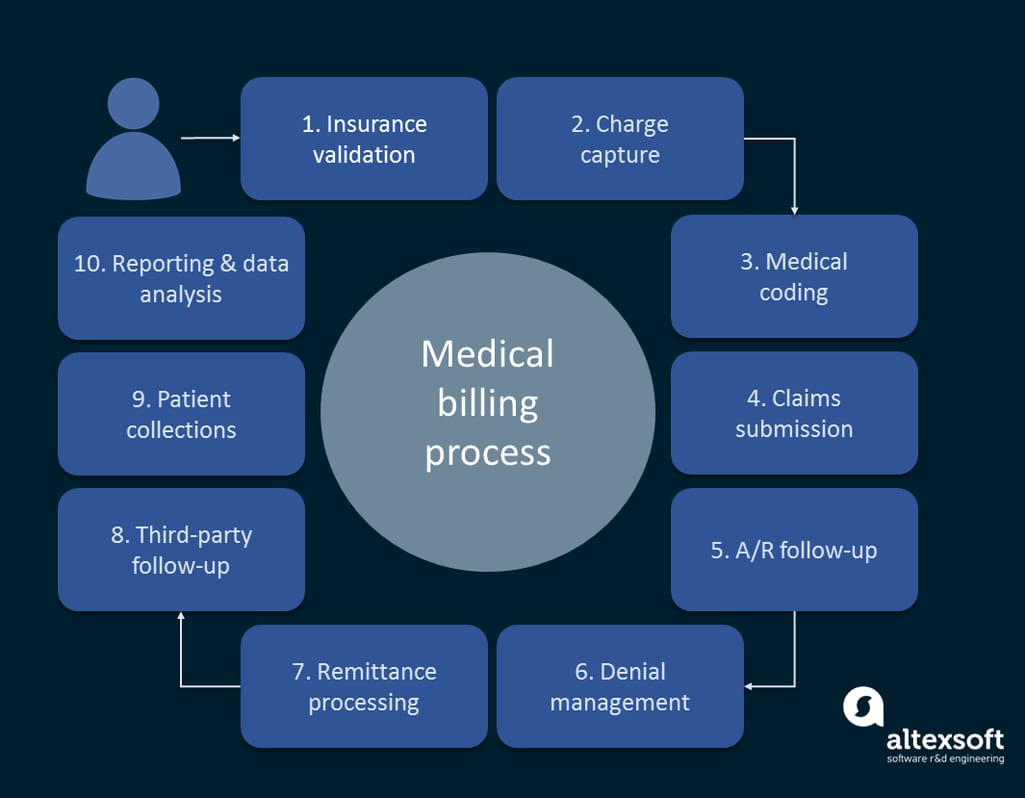
Medical billing workflow.
Patient insurance validation verifies whether a patient's insurance coverage is valid. The procedure is usually done by administrators at the front desk before scheduling an appointment with a doctor. A healthcare facility also collects demographic information about a patient including their medical history with diagnoses, frequency of appointments with physicians, previous charges, charge-sheets, etc.
Charge capture records rendered medical services and charges. It is usually performed by doctors or other healthcare providers.
Medical coding converts medical services, treatment procedures, diagnoses, and prescriptions into standard healthcare codes. The codes must be assigned accurately per Current Procedure Terminology (CPT), International Classification of Diseases (ICD-10), and Healthcare Common Procedure Coding System (HCPCS) standards.
Claims submission is the auditing and submitting of billable fees to the insurance companies for reimbursement.
Accounts receivable or A/R follow-up ensures that healthcare providers will be able to recover overdue payments. Simply put, accounts receivable represents money patients owe to a hospital for services provided. The A/R follow-up involves keeping track of denied claims, checking partial payments, re-filing claims, and other important operations.
Denial management is about tracking common denial reason codes. It reveals billing, registration, and medical coding process weaknesses. The problems are then solved to cut down on future denials and ensure the acceptance of claims the first time.
Remittance processing means the inspection of payments resulting from a bill for rendered medical services to regulate whether the payments should be accepted or denied.
Third-party follow-up includes collecting payments from third-party payers. The step is crucial as organizations can only bill Medicaid or Medicare after they tried other options.
Patient collections gather all the copays and non-covered charges from patients in case a bill for healthcare services is covered only partially by insurance.
Reporting and data analysis aims at improving the financial operations of a healthcare facility by extracting insights from data.
If done manually, these steps require a lot of time, paperwork, and human resources increasing operational costs. Besides that, the higher probability of errors in coding and claims leads to increased payment denials and affects an organization's cash flow.
To deal with these challenges and streamline the entire process, providers need efficient medical billing software.
Key modules of medical billing software programs
Medical billing software automates almost every part of the healthcare billing workflow from scheduling a doctor’s appointment to processing electronic payments. We've singled out the core components and capabilities a medical billing app needs for effective work.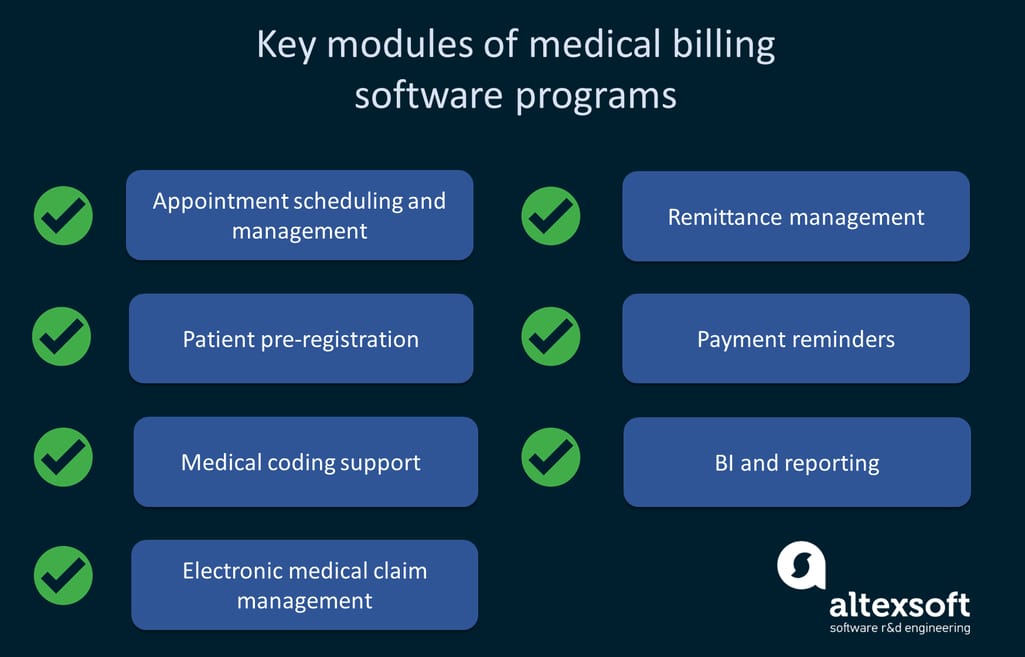
The checklist of key medical billing app modules.
Appointment scheduling and management. Convenient patient scheduling connected to your billing simplifies the management of all appointments as it takes only a few clicks to check previous visits, no-shows, cancellations, and planned encounters.
Appointment scheduler dashboard. Source: AdvancedMD
Patient pre-registration. Some patients might be unaware of their current insurance status, so it is always a good idea to have suitable functionality to do the pre-registration check-up. Insurance eligibility validation before scheduling an appointment saves time and reduces claims denials.
Medical coding support. No matter how great your employees are at medical coding, there's still a decent chance of making a mistake when data is entered manually. The algorithms of some billing programs can scan medical coding for errors and flag whatever needs to be reviewed. In this way, coders make fewer mistakes, increasing the ratio of claims accepted on their first submission.
Electronic medical claim management. Smart claim management is half the success of your medical center. With advanced software, you will be able to implement electronic claim processing, including submitting and tracking your medical claims, checking their status and history, and much more.
Claims denial analysis dashboard. Source: DrChrono
Remittance management. Medical billing software is worth your attention only if it provides electronic remittance functionality. In this way, you will have the capacity of importing and tracking information about all the payments rendered.
Payment reminders. Notifying your patients about overdue or upcoming payments electronically is a must-have feature of medical billing software.
BI and reporting. By opting for advanced and user-friendly billing software with BI or business intelligence tools and reporting features, you will get access to a wide array of useful insights such as financial reports, patient history, practice reports, etc.
Medical billing software tab with reports. Source: Kareo
Questions to ask before picking medical billing software
You need to make sure that the solution you consider fits your practice. We suggest that you find answers to the following questions before deciding to go with one or another vendor.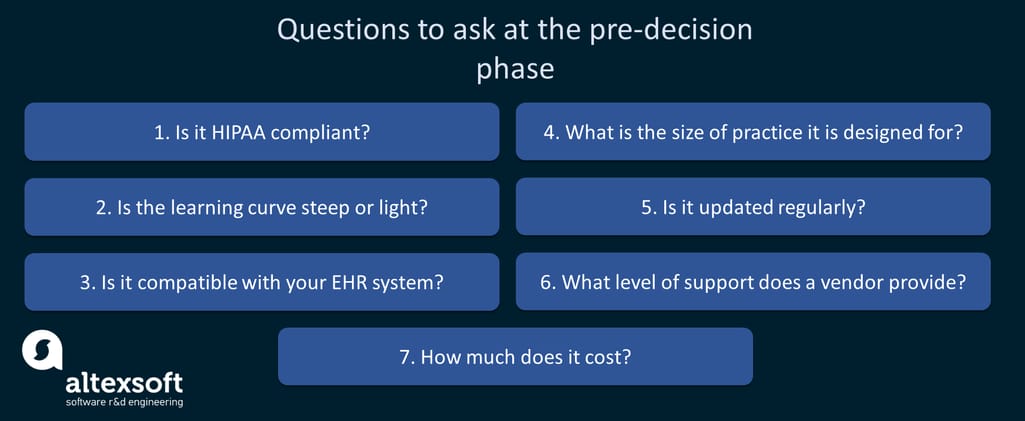
Questions to ask at the pre-decision phase.
Is it HIPAA-compliant?
As all medical establishments are subject to the Healthcare Insurance Portability and Accountability Act (HIPAA), taking care of data security compliance has to be a top priority. Under US law, medical software must be HIPAA-compliant, but it's always a good idea to double-check a provider you pick.
Is the learning curve steep or low?
Purchasing a medical billing software program is only half the deal. Its efficiency largely depends on the ability of your staff to use the functionality to the fullest. This, in turn, relies on the learning curve. Whereas some applications have pretty straightforward and intuitive interfaces, others need to be examined thoroughly to explore their full potential. Before you pick a solution, find out if the learning curve is steep or light. Some vendors offer useful guides and video tutorials that explain how to work with their automated billing services.
Is it compatible with your EHR system?
In case you already have an EMR or EHR (and/or other practice management software) in place, reach out to your EHR vendor first to find out if they offer medical billing services as it is the best way to get smooth integration. Otherwise, make sure that the chosen application is compatible with your existing IT infrastructure and what it will take to connect your new app with other pieces of software to achieve interoperability. You may need to find a third-party tech provider to solve integration problems.
What is the size of practice it is designed for?
It makes sense that practices with a high patient volume may need a different medical billing software program than those with just a few daily encounters. It is worth asking your potential software provider if a product is designed for practices like yours. Also, decide what type of application you need: software to host on your local network, a cloud-based app, or a SaaS (software-as-a-service) product.
Is it updated regularly?
As we have already mentioned, healthcare requirements and regulations are constantly changing. That means you need to make sure that the application you want to opt for is updated regularly. On top of that, learn whether or not updates are offered throughout the whole period you use the app. Some software providers do not include updating in certain pricing plans.
What level of support does a vendor provide?
While such a thing as support isn't built into medical billing software, it shouldn't be underestimated. Some vendors give a direct phone number to call 24/7 to have the issue resolved right away whereas others are only available via email during certain working hours. It is recommended to look for a provider that offers all kinds of support including email, telephone, and online chats.
How much does it cost?
Medical billing software pricing plans differ greatly. There are a couple of influencing factors involved. Vendors usually offer cheaper solutions and per-encounter plans for solo practices with a lower number of patients and more expensive packages for mid-sized and large practices. At the same time, medical billing software costs also depend on the features included. If, say, you look for advanced reporting and scheduling functionality or credit card processing, you may need to pay extra.
Reviewing top medical billing solutions
Finding the most fitting software product can be an overwhelming task. Platforms like Software Advice offer an impressive list of more than 300 products. By applying filters, you can narrow down the choices, but there's still a lot of research work left to be done. To help you out, we have selected the top 5 medical billing applications that deserve your attention.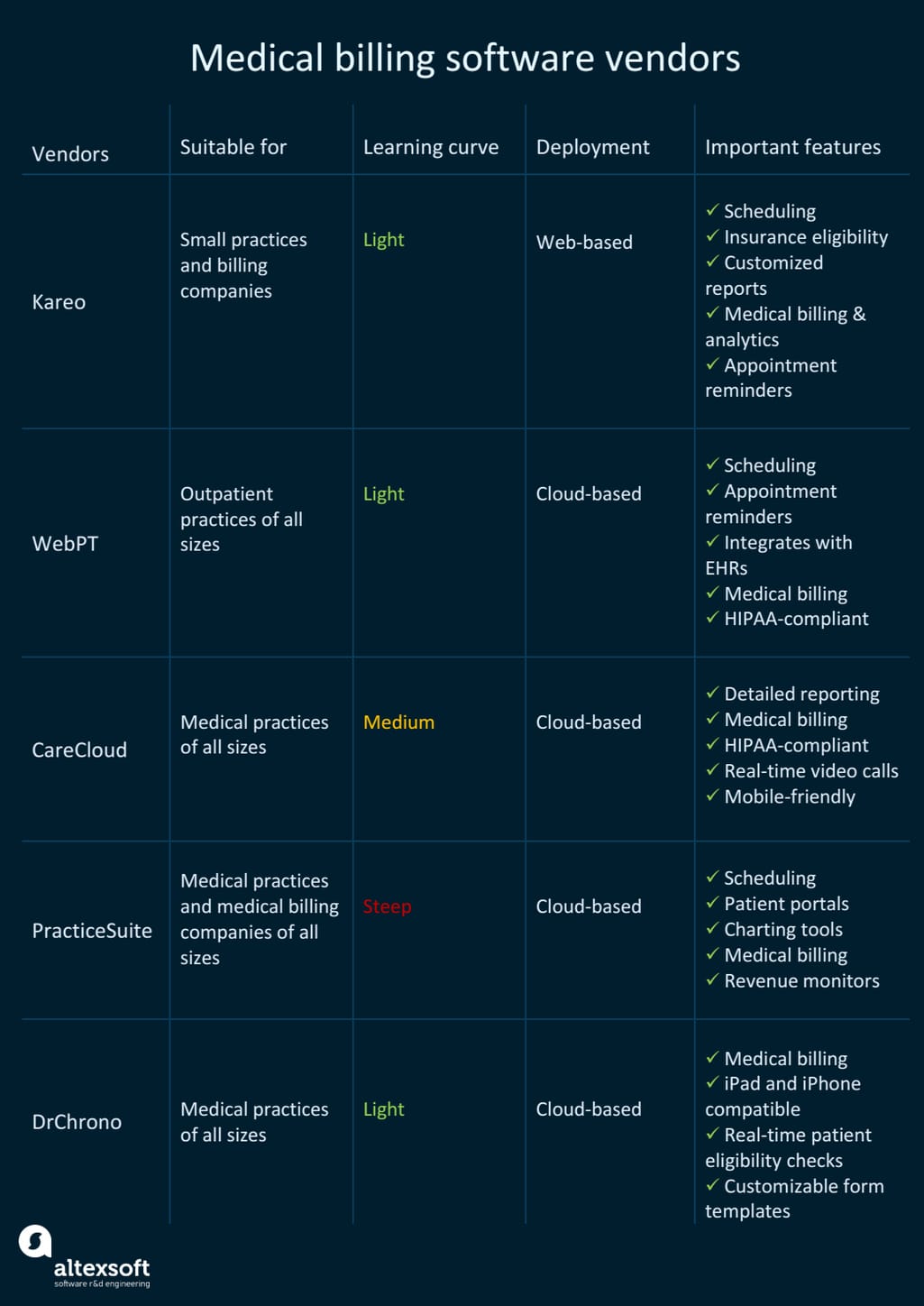
Comparison of the top medical billing software vendors.
Kareo: medical billing software built for the unique needs of practices
One of the best-rated medical billing technologies, Kareo is a web-based, all-in-one platform used by medical practitioners and billing companies to streamline their workflows.
Kareo website home page.
The Kareo billing software solution allows for scheduling patient appointments, managing payments, processing claims, storing documents, creating custom reports, and more. Kareo has a great layout and an easy-to-use functional dashboard. Mobile-friendly Kareo offers messaging functionality so that physicians can communicate with patients, insurers, and employees conveniently.
As an ICD-10 compliant medical solution, Kareo can be used by small to medium practices of different specialties including mental health, pediatrics, cardiology, etc. Some users point out there is little support for natural products/supplements and issues with customer support.
WebPT: user-oriented EMR system with advanced billing features
An electronic medical records (EMR) system at its core, WebPT offers a wide array of RCM and medical billing features. Launched in 2008, WebPT is a cloud-based, multi-purpose platform that works well on all popular operating systems including Mac OC, Windows, and Linux. Those who opt for WebPT will be provided with various useful features such as patient scheduling, practice insight reporting, and outcomes tracking, to name a few.
WebPT board with billing records and CPT codes.
Also, the platform can be integrated with an array of EHR platforms. The WebPT software is Medicare- and HIPAA-compliant. While some find the visual interface somewhat basic, they claim that the platform is efficient and user-friendly even for the technically challenged users.
CareCloud: convenient EHR and medical billing solution
CareCloud is another medical billing software that is known for being very easy-to-use. It is a cloud-based platform that offers great communication between the vendor and the client.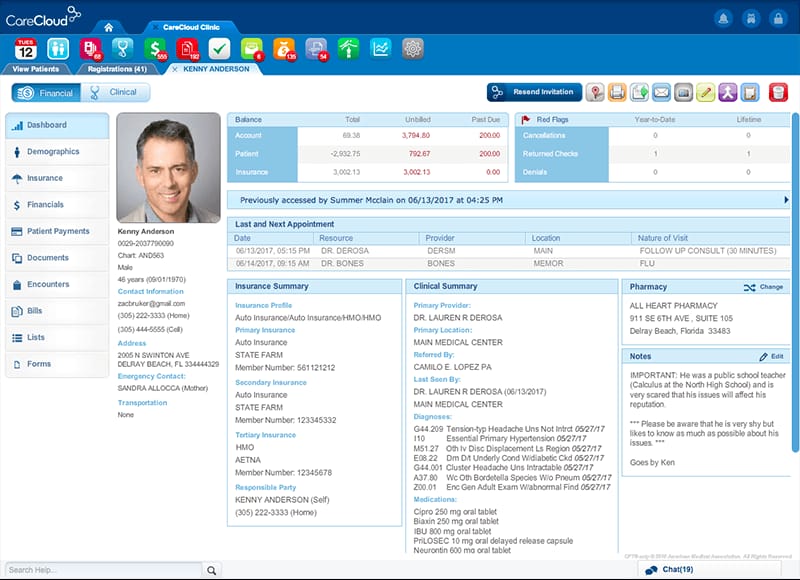
CareCloud medical billing program dashboard.
Along with efficient billing modules, CareCloud has convenient reporting and notes modules. The solution can be easily tailored to users' preferences. Though a little bit pricey, the solution provides collective benefits of practice management, EMR, and medical billing services altogether as it streamlines most operations and allows for paper-free workflow.
CareCloud offers pre-designed templates for prescription, reporting, or billing that can also be customized. It ensures a fast turnaround with payments from insurance companies.
PracticeSuite: cost-effective PM and medical billing software
PracticeSuite is an all-in-one, patient-oriented practice management (PM), electronic health record (EHR), and medical billing platform tailored to the needs of medical practices and third-party billing companies of any size.
PracticeSuite operational dashboard.
Apart from patient scheduling and outreach, PracticeSuite provides advanced tools for online reviews. PracticeSuite is a cloud-based system with affordable per-provider pricing plans with no subscription or cancelation fees.
When billing the same codes, providers can save time as the system allows for copying the last billing. The system also keeps all your payments in one place and provides automated dashboard alerts.
Users single out the advanced reporting features of the program and strong customer support service. With all these advantages, the system has a fairly steep learning curve and accounting can be off sometimes.
DrChrono: EHR software with robust billing features
DrChrono is an advanced EHR and medical billing software platform providing the full function for any practice. It consists of web- and cloud-based applications for doctors and patients.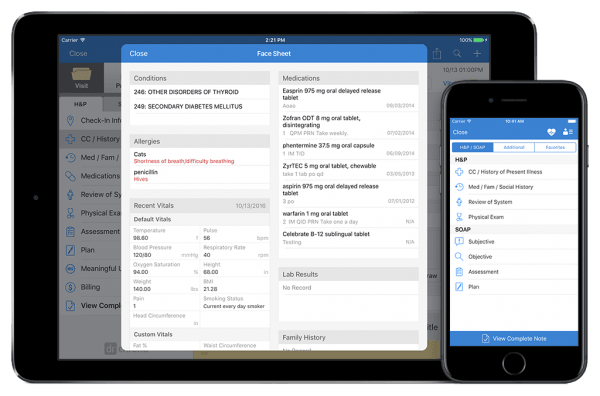
DrChrono can be used across various devices.
The DrChrono billing system can be integrated with the MacBook, iMac, and iPhone, which is a great advantage for many users. Being an easy-to-use medical billing software, DrChrono can be customized for any practice.
Among multiple useful features, the system comprises customizable medical forms, robust scheduling tools, e-prescribing, and real-time patient insurance eligibility checks. At the same time, users admit that some of the features don't function as well as advertised and customer service could have been better.
Benefits billing software brings and challenges it solves
As we’ve already mentioned, by implementing the right solution, a healthcare facility gains important competitive advantages. The software automates tricky operations, bringing the following improvements.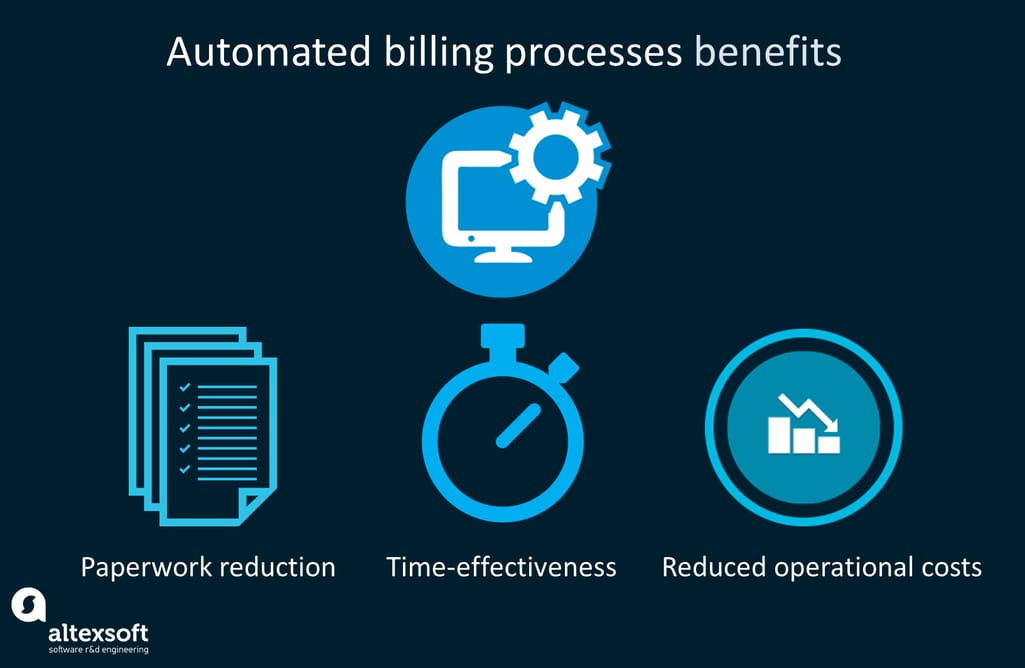
Benefits brought by the automation of medical billing.
Paperwork reduction. All the billing processes that formerly required tons of paper documents to be filled, sent, and processed can now be performed electronically. This, in turn, results in fewer errors and less rework.
Time-effectiveness. Medical billing software considerably streamlines physician practice operations as most solutions come with functionality that allows for submitting and processing hundreds of claims through a single interface. It has been calculated that healthcare providers can save about 1.1 million labor hours per week by switching to electronic transactions.
Reduced operational costs. Purchasing and implementing medical billing software can be costly but the investment pays off. On average, a manual transaction costs medical providers $6 more than when done electronically. The automation of billing tasks can cut down operational expenses by more than 55 percent and boost revenue.
Among multiple pain points your current billing process may have, we’d like to emphasize three crucial issues this type of software addresses.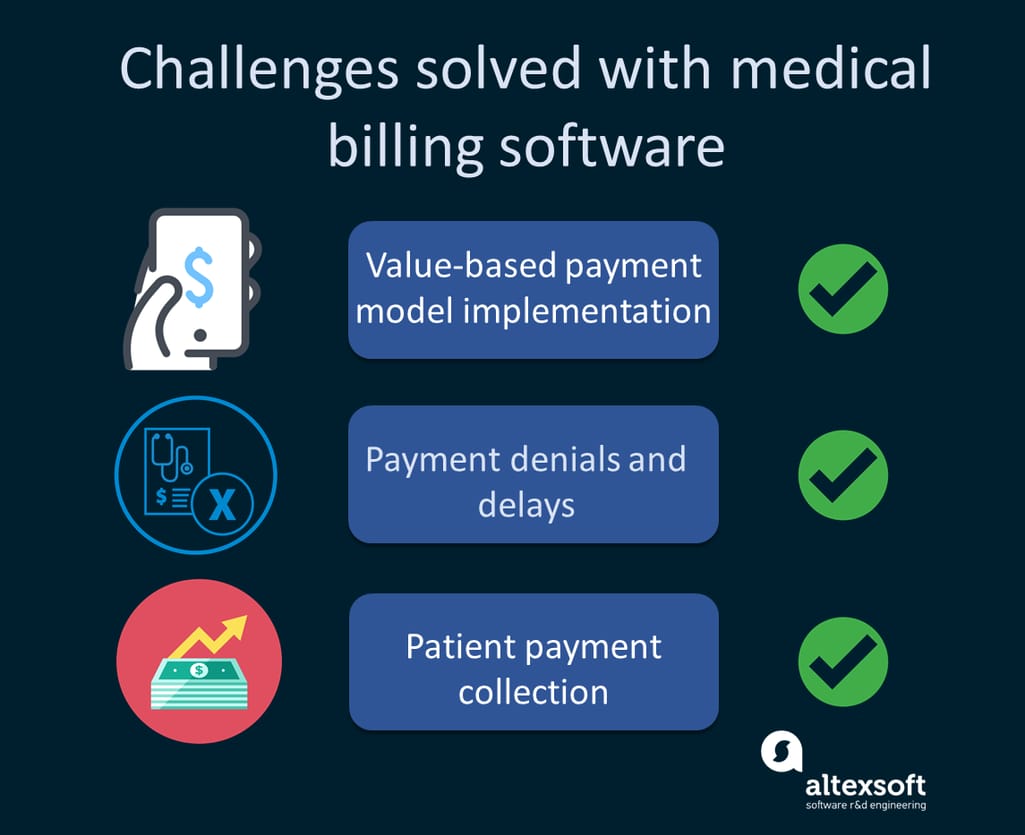
Challenges solved with medical billing software.
Value-based payment model implementation
With the shift of Medicare and Medicaid payment policies from the volume of care to the quality of care delivered, many vendors face problems with transitioning to value-based reimbursement practices. Within the new model, healthcare providers' reimbursement depends on patient health outcomes.
Data generated with the help of medical billing software can provide insights into the care trends and determine areas of patient needs. In this way, providers get to measure outcomes and coordinate care more efficiently ending up with better time management and increased profit.
Payment denials and delays
According to a recent Healthcare Information and Management Systems Society (HIMSS) survey that interviewed CEOs, CIOs, CFOs, Directors of IT and Finance, and Heads of RCM in medical facilities, denials are the biggest revenue cycle management issue for health systems. The reasons for denials vary from missing information and insurance validation errors to mistyped digits in medical codes. The time wasted on verifying charges on medical services costs millions of dollars for health institutions.
Thanks to the implementation of medical billing software and appropriate staff training, it is possible to minimize denials and delays in reimbursement. Computer programs automatically scan input data for mistakes and send error alerts. Besides that, programs collect data about denied claims and help discover patterns within them, providing insights on how to prevent denials and avoid revenue loss.
Patient payment collection
This procedure also presents its set of complexities. As treatment costs increase, more patients face a need to pay charges independently due to the absence or lack of insurance coverage. Subsequently, the management of copayments and deductibles becomes a problem for some patients, resulting in delayed payments, insolvency, and receivables.
Electronic medical billing systems speed up the process of collecting patient payments thanks to the advanced notification functionality that sends billing reminders through text messages and email. Owing to data interchange tools, it is possible to include direct links to payment platforms so that there's no confusion on the part of a patient. And that leads to streamlined financial operations and accelerated cash flows.
When to consider a custom solution?
Modern billing systems take care of many time-consuming administrative tasks, allowing physicians to focus on care delivery rather than on claim submission. But even given a wide variety of apps with rich functionality, sometimes neither of them can meet the unique needs of a particular medical institution. Dental clinics, mental health centers, hospices, pharmacies, and other organizations may need custom solutions or additional features to replace paper-based claims processing and boost the speed and accuracy of medical billing.


